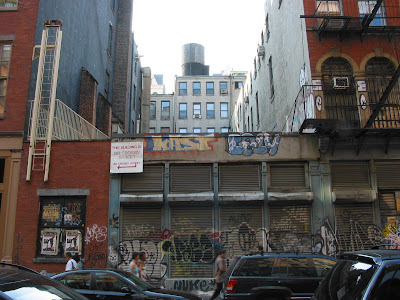
I work on Crosby Street in Manhattan. It borders several neighborhoods, but belongs to none. It is neither Chinatown, nor SoHo, nor a no-man's-land in between. The more I travel around the city, the more Crosby Street sticks out, but it has no single definition. As gentrification tempers much of Manhattan, Crosby remains eclectic.
It starts at a dead-end, untouched by the raucous commerce of Canal Street, just one block south. Then it marches straight north for five blocks before crossing Houston Street. Here, eight lanes of traffic pause every few moments to let Crosby Street go on it's way. If you're waiting in Houston traffic, you can turn north onto Crosby, but you won't find much. One block later, Crosby Street meets Bleecker Street and expires.

To the west, there's Broadway and the boutiques and galleries of SoHo. To the east of Crosby, Lafayette Street forms the border of Chinatown and Little Italy, which lie just beyond.
I'm not the only one who can't figure out where Crosby Street belongs. The Historical Commission was going along just fine until they got here. They knew that the west side of the street was definitely SoHo - a Cast Iron Historic District if they ever saw one. But the eastern half of Crosby Street must have
failed the test. It received no designation.
While SoHo swells with shoppers and strollers, Crosby Street works for a living: There's a wholesale produce market, hardware stores, warehouses, delis, and loading docks for the big box stores on Broadway. At noon, white-uniformed chefs huddle for a smoke break at the back entrance to the French Culinary Institute, and delivery trucks idle on the sidewalks.
Oh, but Crosby has luxury too. You can enter Bloomingdales on Crosby Street, as well as the MOMA Design Store and Starbucks (though both use a Spring Street address). At other stores, you can outfit your home with fine lighting, excellent rugs, and incredible faucets. If you happen to be a millionaire, you can even afford to buy an apartment here.
It's easy to identify physical attributes, but the street relies on people for it's lifeblood. If each individual perceives the street in their own way, the plurality of viewpoints would seem to rule out absolute definitions. But this almost never happens. In Manhattan, Avenue A is the East Village, Columbus Avenue is the Upper West Side, Hester Street is the Lower East Side. These streets are badges for their neighborhoods, and in a city obsessed with real estate, every neighborhood is a
commodity. Does this one come with artists or investment bankers? Hipsters or yuppies? Peanut butter or chocolate chips?
Crosby Street seems unaffected by that game. The street holds on to it's own character, and that's good enough for me. Here, you'll find some history, some observations, and some photos of Crosby Street as it appeared for a few months in late 2007. Welcome and enjoy.

 On first impression, it's easy to dismiss dumpsters, dripping scaffolds, and permanent construction sites as blots on the urban landscape. If you want to make that argument, a year on Crosby Street will give you plenty of ammunition.
On first impression, it's easy to dismiss dumpsters, dripping scaffolds, and permanent construction sites as blots on the urban landscape. If you want to make that argument, a year on Crosby Street will give you plenty of ammunition.



















